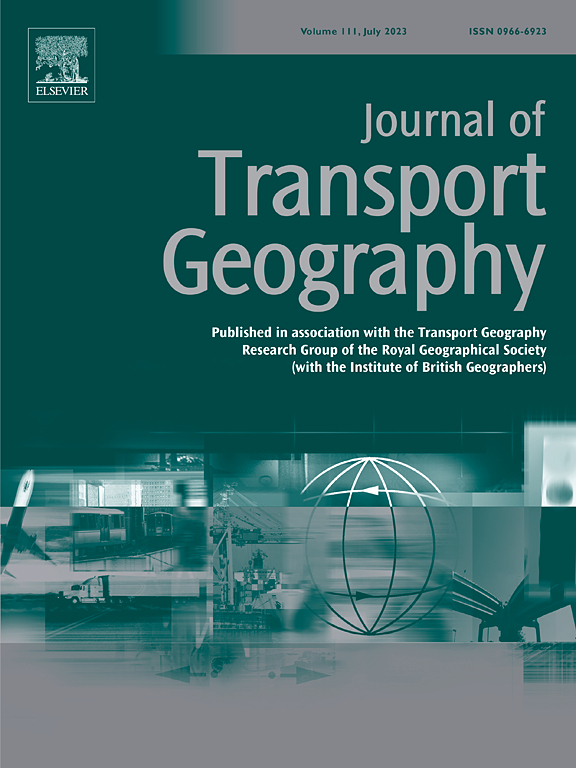共享微出行与公共交通的关系:共享单车与共享电动车的区别
IF 5.7
2区 工程技术
Q1 ECONOMICS
引用次数: 0
摘要
关于共享微交通的使用模式和潜在影响已经进行了广泛的研究,但共享自行车和共享电动自行车这两种中国主要的微交通模式与公共交通的不同关系仍未被探索。研究远离公共交通的潜在不同的交通模式转变模式对于了解不同微交通模式的景观及其对传统交通模式的不同破坏至关重要。为了弥补这一差距,本研究分析了来自中国宁波的共享微出行数据,旨在量化共享微出行与公共交通之间的关系,并区分共享单车和电动自行车与公共交通的互动。我们采用基于地理空间的方法,将每个共享微移动出行分为三种类型:模态替代(MS)、模态整合(MI)和模态互补(MC),基于它们与公共汽车和地铁的互动。在此基础上,利用空间自回归(spatial Autoregressive, SAR)模型分析了城市居民出行频率的时空变化规律,并分析了影响这些变化关系的因素。我们的研究结果表明,共享电动自行车更多地取代公共交通,而共享自行车主要用于MC角色。共享电动自行车和自行车的使用存在显著的时空差异:在时间上,共享电动自行车存在替代公共交通的早高峰;在空间上,共享电动自行车在郊区的替代集中度更高,而共享自行车在郊区的互补集中度更高。电动自行车和自行车与公共交通关系的差异很大程度上受行程距离、速度和公共交通特征的影响。本研究强调了认识不同共享微出行方式与公共交通之间多种互动关系的重要性,并为共享微出行和公共交通系统的发展和管理提供了启示。本文章由计算机程序翻译,如有差异,请以英文原文为准。
Relationship between shared micromobility and public transit: The differences between shared bikes and shared E-bikes
Extensive research has been conducted on the usage patterns and potential impacts of shared micromobility, yet the distinct relationships with public transit between shared bikes and shared E-bikes – the two main micromobility modes in China – remain unexplored. Examining the potentially distinct modal shift patterns away from public transit is essential to understand the landscape of different micromobility modes and their different disruptions to traditional transportation modes. To bridge this gap, this study analyzed shared micromobility trip data from Ningbo, China, aiming to quantify the relationship between shared micromobility and public transit, and differentiate between the interactions of shared bikes and E-bikes with public transit. We employed a geospatial-based approach to categorize each shared micromobility trip into three types: Modal Substitution (MS), Modal Integration (MI), and Modal Complementation (MC), based on their interactions with buses and subways. Then we explored the spatial and temporal patterns of the shares of MS, MI, and MC trips, and investigated factors influencing these varied relationships using Spatial Autoregressive (SAR) models. Our findings indicate that shared E-bikes more frequently substitute for public transit, whereas shared bikes are predominantly used in MC roles. There are notable temporal and spatial variations in the usage of shared E-bikes and bikes: temporally, there is a morning peak of shared E-bikes that substitute public transit, and spatially, E-bike sharing has a higher concentration of substitution in suburbs while bike sharing has a higher concentration of complementation in the outer areas. The observed differences between E-bikes and bikes regarding their relationship with public transit are largely influenced by trip distance, speed, and public transit characteristics. This study highlights the importance of recognizing the diverse interactions between different shared micromobility modes and public transit, and sheds light on the development and management of shared micromobility and public transit systems.
求助全文
通过发布文献求助,成功后即可免费获取论文全文。
去求助
来源期刊

Journal of Transport Geography
Multiple-
CiteScore
11.50
自引率
11.50%
发文量
197
期刊介绍:
A major resurgence has occurred in transport geography in the wake of political and policy changes, huge transport infrastructure projects and responses to urban traffic congestion. The Journal of Transport Geography provides a central focus for developments in this rapidly expanding sub-discipline.
 求助内容:
求助内容: 应助结果提醒方式:
应助结果提醒方式:


